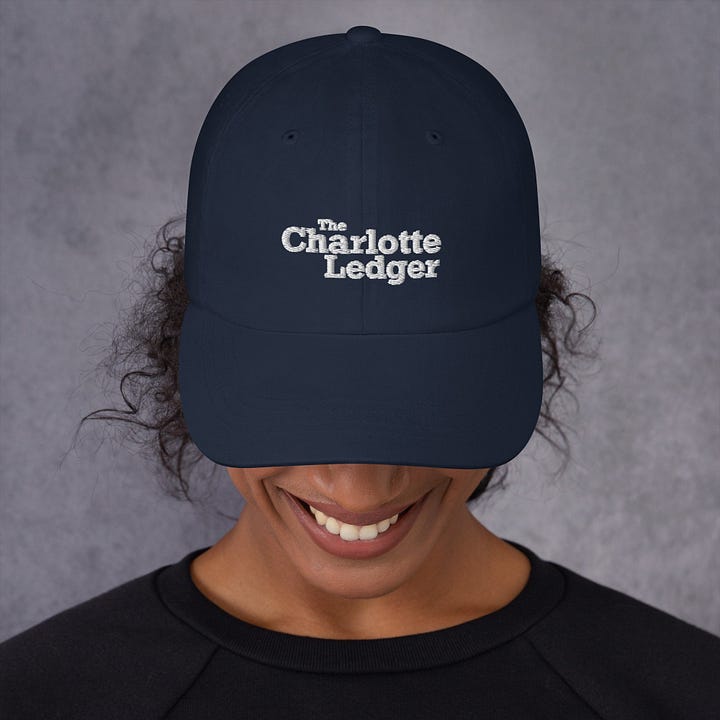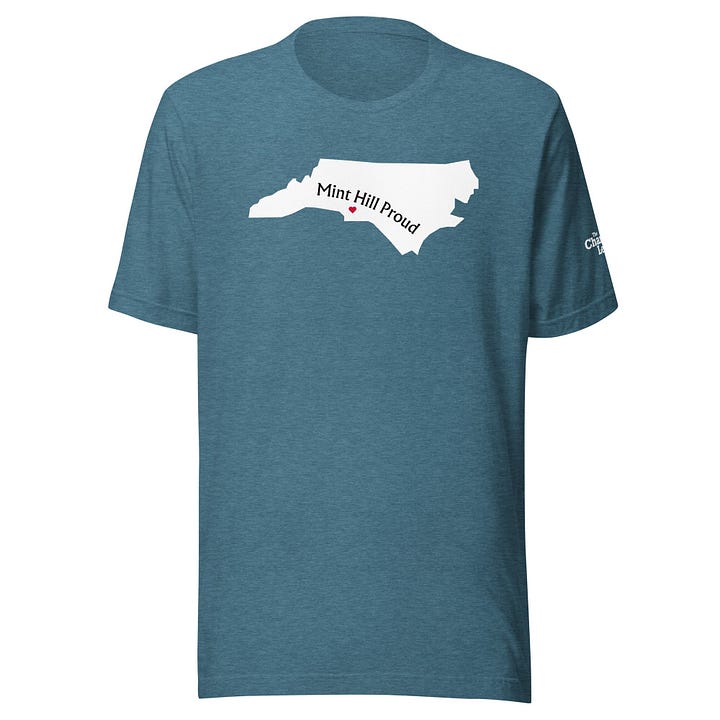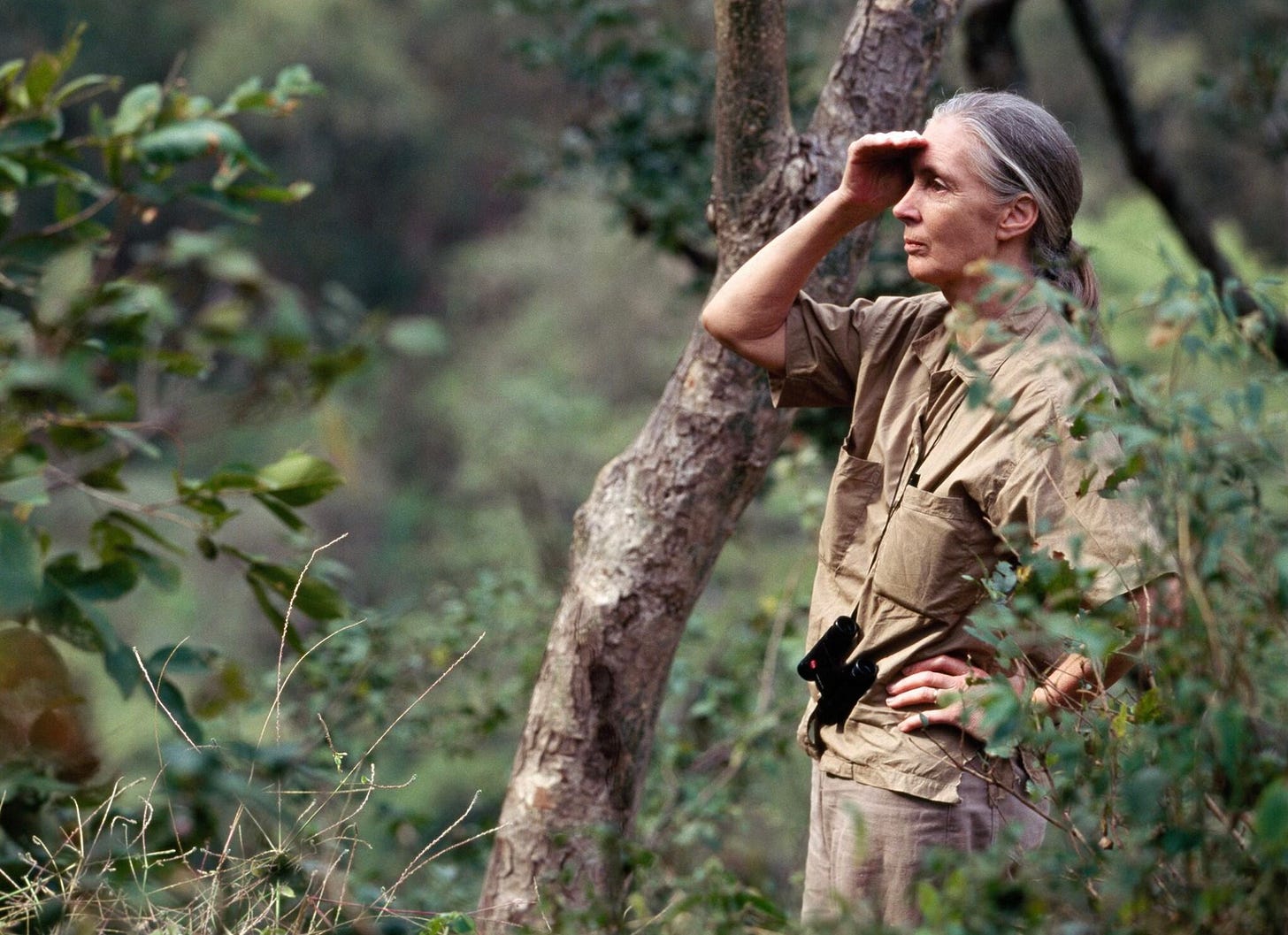Explore Jane Goodall's remarkable journey
Plus: The news of the week — Historic Carolina Theatre reopening; Higher speed limits ahead?; New high school sports conferences proposed; CMS hit by federal budget cuts
Good morning! Today is Saturday, February 22, 2024. You’re reading The Charlotte Ledger’s Weekend Edition.
Need to subscribe — or upgrade your Ledger e-newsletter subscription? Details here.
Today’s Ledger is sponsored by Tryon Medical Partners. As an independent practice, the difference is personal. Leading with award-winning primary care at several locations across the Charlotte region, we build stronger relationships that lead to better health.
‘Becoming Jane’ – A deep dive into a deep mind at Discovery Place
Jane Goodall, 35 years after her original observations, finding great joy in watching the Gombe chimpanzees in Gombe National Park, Tanzania. (Michael Nichols photo)
By Lawrence Toppman
She lay down with earthworms and rose up to be the world’s foremost expert on chimpanzees. To learn what happened during the eight decades in between, visit “Becoming Jane: The Evolution of Dr. Jane Goodall.”
The exhibit stays at Discovery Place Science through April 19, courtesy of National Geographic and the Jane Goodall Institute. The animal rights icon will turn 91 during the last month of the run, so the life-size hologram in it may be the closest you’ll come to seeing her in person.
I saw her in the spare, tanned flesh about 20 years ago, when she spoke at Belk Theater. What I remember most is not her insight, curiosity or compassion, all evident in the exhibit at the uptown museum, but her patience: She sat in Founders Hall and signed books good-humoredly, until every person in a queue the size of a Blue Line train had been satisfied.
In a way, her whole life has been about patience. As a girl, the exhibit tells us, she spent five motionless hours in a henhouse to determine how a chicken lays an egg. She made meticulous drawings of the front and side views of insects’ heads. (Her mother had long since found 18-month-old Jane lying in bed with earthworms to observe their behavior.)
When Goodall got to Gombe Stream Game Reserve in 1960, shy chimpanzees tested that patience. She spent 12 hours a day sitting quietly, eating a prisoner’s diet of bread and coffee, to win their trust. After some months, they let her watch them grooming. Much later she could touch them, play with them, eat with them — all things researchers no longer do, keeping their distance, but behaviors that gave her unprecedented access to chimps’ thoughts and feelings.
That chimps had thoughts and feelings, distinct personalities that made them easily identifiable, stunned the scientific world. (They share 98% of humans’ DNA, so perhaps it should not have.) That they used implements to accomplish tasks caused an uproar: Man was no longer the world’s only toolmaker. And as Goodall painstakingly amassed data and anecdotes for a quarter-century, the world often had to revise its thinking.
The exhibit covers all this ground thoroughly and interactively: You watch short films, listen to her talk about her work, even learn to reproduce chimp calls from a video, if you lack inhibitions. Yet the freshest part for me came in the pre-Gombe years.
We meet the little girl whose mother encouraged inquisitiveness at every extreme. (Parents, please note.) We see the avid reader who devoured “Dr. Dolittle” and “Tarzan of the Apes” and, later, Tolkien’s fantasies. “I fell in love with Tarzan and was very jealous when he married the wrong Jane,” she recalls in one of the helpful wall panels.
She labored as a waitress and secretary and chauffeur to an orangutan: Annabelle, who travelled between the London Zoo and the film studio where Goodall chose music for documentaries. A photo shows Jane in her early 20s in the driver’s seat, even then regarding her companion with an expression that questions the rightness of Annabelle’s treatment.
By the time she got to Gombe at 26, accompanied by her mother as chaperone and an African cook, her personality had fully been formed and her dream of living in Africa realized. Her mentor, anthropologist Louis Leakey, worked on the northeastern side of Tanzania, digging up evidence of the oldest humans at Olduvai Gorge. Goodall worked on the northwestern side, digging up facts about our simian cousins with Leakey’s financial backing.
She married a National Geographic photographer, had a child she nicknamed Grub, divorced the photographer and remarried a man who would become director of Tanzania’s national parks system. And though we think of her first as a researcher, she spent only the first third of her scientific life that way. She has devoted the last four decades to the protection of chimps and the preservation of their environment.
The final room of “Becoming Jane” strikes a careful balance between peril and promise. We learn about the dangers facing chimps today: deforestation of their home, illegal trapping to sell them as bushmeat or pets or abused animals in unlicensed zoos, diseases chimps and humans pass between each other in unregulated encounters, the harsh effects of global warming.
But the exhibit closes with hope. The Jane Goodall Institute in Tanzania has helped replenish native forests. And Goodall, smiling her serene smile in a video, offers five reasons for her belief that things will get better: the indomitable human spirit, social media, the resilience of nature, the adaptability of the human brain and the power of young people. She believes yet-unknown kids who are becoming Jane all over the world will pull us out of our ongoing global mess.
If you go…
➡️ “Becoming Jane” runs at Discovery Place Science, 168 W. 6th St., through April 19; admission to the exhibit is included with your ticket. Parking tip: I paid $18 for two hours in the adjacent Discovery Place parking garage, after a 25% discount offered to museum guests. I could have parked a block away on the street for less than $4 for the same length of time.
Lawrence Toppman covered the arts for 40 years at The Charlotte Observer before retiring in 2020. Now, he’s back in the critic’s chair for the Charlotte Ledger — look for his reviews about three times each month in the Charlotte Ledger. Check out this link for Toppman’s archive of reviews in the Ledger, and you can listen to him talk about being an arts critic in this recent episode of the Charlotte Ledger podcast.
This week in Charlotte: Belmont Abbey president retiring; Lead found in county park; Duke fined in worker death; CATS plans lack ridership details; Charlotte FC kicks off season
On Saturdays, The Ledger sifts through the local news of the week and links to the top articles — even if they appeared somewhere else. We’ll help you get caught up. That’s what Saturdays are for.
Education
Federal grant cuts affect CMS: (WFAE) Charlotte-Mecklenburg Schools is facing budget challenges as three federal grants, totaling nearly $7M, were abruptly cut. CMS officials warn that additional federal education funds, including Title I, could also be at risk.
New conferences proposed for high school sports: (Observer) A committee of the N.C. High School Athletic Association has released its final draft of proposed new conferences. Under the proposal, Charlotte Catholic would join teams in Union County; Berry, Harding and Olympic high schools would join teams in Cabarrus County; and the remaining Charlotte-Mecklenburg schools would be divided into three conferences.
Belmont Abbey president to retire: Bill Thierfelder will retire as president of Belmont Abbey College on Aug. 2, after 21 years of leadership, according to a press release. He plans to return as a faculty member in 2026.
Politics
Higher speed limit ahead? (WRAL) A bipartisan bill filed last week in Raleigh would allow the top highway speed in North Carolina to be raised to 75 mph, up from 70 mph.
Late reports: (WFAE) Several Charlotte City Council members are more than a year late in filing campaign finance reports as required by state law.
Local news
Lead found in county park near South End: (Ledger 🔒) Elevated lead levels discovered in the soil at Southside Park have led Mecklenburg County to fence off its sports fields while state regulators conduct tests and officials consider costly remediation options.
Symphony to return to site of its 1932 debut: (Ledger 🔒) After eight years of renovations and a $90M investment, the historic Carolina Theatre in uptown is reopening, with the Charlotte Symphony headlining its return on March 28 alongside soprano Renée Fleming.
Duke Energy fined in worker death: (WSOC) The N.C. Department of Labor fined Duke Energy $16,000 in connection with the electrocution of one of its linemen last summer.
From the Ledger family of newsletters
Wednesday (🔒)
Weddings go small: Micro-weddings, a trend that gained popularity during the pandemic, continue to appeal to couples seeking intimate, personalized ceremonies that prioritize meaningful experiences over large, traditional weddings.
Plus: Out-of-state Belk employees feel pushed out
Friday (🔒)
He had a front-row seat to N.C. politics: On a recent episode of The Charlotte Ledger Podcast, longtime political strategist Carter Wrenn reflects on his decades in North Carolina politics in a new book, sharing candid insights on U.S. Sen. Jesse Helms, the evolution of political tactics and his own regrets about race-based campaign strategies.
Plus: Real Estate Whispers goes inside new office tower; Isabella Santos Foundation switches up grants; Pop-up bookstore owner pushes subscriptions
Ways of Life (🔒)
Melody Lowery Reed was a gifted musician, songwriter and seamstress whose fearless creativity, generosity and love for family left a lasting impact on everyone she met. She passed away Jan. 20 at 82.
No ridership projections included in 4 latest transit scenarios: Charlotte Area Transit System presented four transit expansion scenarios without ridership projections, raising concerns about decision-making, funding eligibility and efficiency as officials plan for a potential sales tax increase to support the project.
Charlotte FC kicks off its fourth season tonight in Seattle. The Ledger’s Carroll Walton breaks down the 10 things you should know that have changed for this season and takes a closer look at new star Wilfried Zaha.
New Charlotte FC star Wilfried Zaha is one of the team’s changes as it enters its fourth season, which starts tonight. Get up to speed with Charlotte FC each week with The Ledger’s Fútbol Friday newsletter. Ledger subscribers can opt into it on their account page (under “notifications”). (Photo courtesy of Charlotte FC)
Is your wardrobe ready for a Charlotte upgrade?
Spring will be here before you know it, and it’s the perfect time to refresh your wardrobe with threads from The Charlotte Ledger Merch Store!
Whether you're looking for a cozy hoodie for those crisp mornings, a lightweight T-shirt for sunny afternoons, or a hat to top off your look, we’ve got you covered. Every item is designed with Charlotte in mind—whether it’s showing off your sophistication with Ledger-themed gear or showing love for your favorite Charlotte neighborhood, from Dilworth to east Charlotte to Gastonia.




Every purchase helps support The Charlotte Ledger, your go-to source for insightful, independent local journalism.
Shop now and grab your favorites!
Need to sign up for this e-newsletter? We offer a free version, as well as paid memberships for full access to all 4 of our local newsletters:
The Charlotte Ledger is a locally owned media company that delivers smart and essential news. We strive for fairness and accuracy and will correct all known errors. The content reflects the independent editorial judgment of The Charlotte Ledger. Any advertising, paid marketing or sponsored content will be clearly labeled.
◼️ About The Ledger • Our Team • Website
◼️ Newsletters • Podcast • Newcomer Guide • A Better You email series
◼️ Subscribe • Sponsor • Events Board • Merch Store • Manage Your Account
◼️ Follow us on Facebook, Instagram, X/Twitter, LinkedIn






